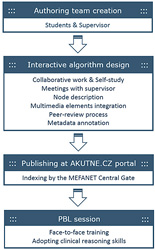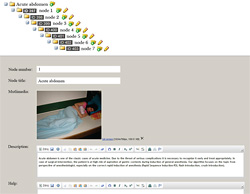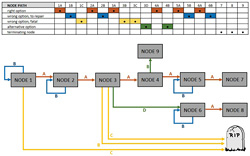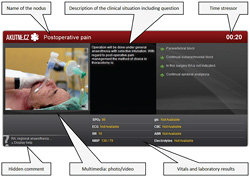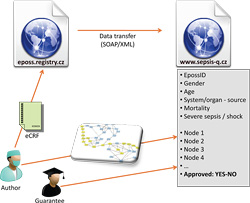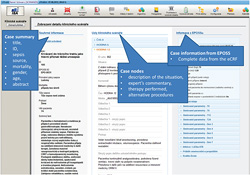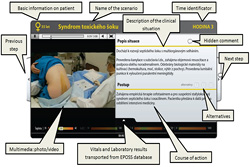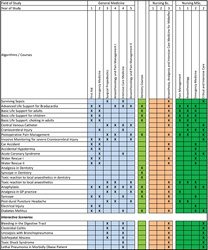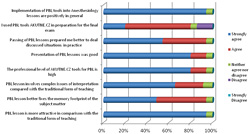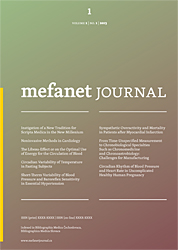
MEFANET Journal 2013; 1(2): 61–73
ORIGINAL ARTICLE
AKUTNE.CZ algorithms and SEPSIS-Q scenarios as interactive tools for problem based learning sessions in medical education
Petr Štourač1,2, Hana Harazim1,2,*, Daniel Schwarz2, Ivo Křikava1, Martin Komenda2, Roman Štoudek1, Olga Smékalová1, Martina Kosinová1, Richard Hůlek2, Jan Maláska1, Radim Šustr2, Ivo Šnábl2, Ladislav Dušek2, Roman Gál1
1 Department of Anaesthesiology and Intensive Care Medicine, University Hospital Brno, Medical Faculty of Masaryk University, Brno, Czech Republic
2 Institute of Biostatistics and Analyses, Masaryk University, Brno, Czech Republic
* Corresponding author: hana.harazim@gmail.com
Abstract
Article history:
Received 30 March 2013
Revised 3 September 2013
Accepted 25 September 2013
Available online 7 October 2013
Peer review:
Jiří Kofránek, Ilja Tachecí
 Download PDF
Download PDF
This paper describes the interactive tools of the AKUTNE.CZ (part of MEFANET) and SEPSIS-Q portals for Problem Based Learning (PBL) sessions in medical education. The portals aim to be a comprehensive source of information and educational materials, covering all aspects of acute medicine for undergraduate medical students and health professionals. Our focus is mainly on simulation-based tools for teaching and learning algorithms in acute patient care, the backbone of the AKUTNE.CZ and SEPSIS-Q portals. Over the last five years, more than 30 interactive algorithms in the Czech and English languages (http://www.akutne.eu) have been developed and published online, allowing users to test and improve their knowledge and skills in the field of acute medicine. Additionally, we have created six SEPSIS-Q interactive scenarios in the Czech version. The peer-reviewed algorithms were used for conducting PBL-like sessions in General Medicine (First Aid, Anaesthesiology and Pain Management, Emergency Medicine) and in Nursing (Obstetric Analgesia and Anaesthesia for Midwives, Intensive Care Medicine). The interactive scenarios serve to demonstrate interesting cases, with preference for Intensive Care Medicine sessions in General Medicine and Nursing.
Keywords
interactive algorithms, medical scenarios, Problem Based Learning, acute medicine, sepsis
Introduction
Acute/intensive care/critical care/emergency medicine is a dynamic and time-pressure environment with high demands on crisp team communication and leadership, accurate clinical reasoning and often, immediate decision-making. Simulating such an environment offers good techniques for training multidisciplinary medical teams, facilitating drilled interaction and coordination, and enabling the team to function as an effective unit [1]. The Internet education resources for critical care medicine have been recently reviewed by Kleinpell et al. [2]. The authors deduce that the majority of these resources are only electronic forms of textbooks and articles rather than interactive algorithms and dynamic simulations. Davids et al. [3] described an interactive web-based simulation in which the user treats patients with electrolyte and acid-base disorders, selects therapies and dosage, and obtains immediate feedback on the treatment results. The GOLEM system devised at the Charles University in Prague (Kofránek et al.) simulates many different clinical situations (e.g. circulatory insufficiency, renal disorders, diarrhoea, etc.) enabling students to learn by experimenting with the basics of physiology [4]. A recent trend in the authoring of virtual patients is to embed them as 3D-characters in virtual worlds, as in the case of Second Life [5], where the user has the option of working on the cases jointly with fellow students via the Internet.
Apart from the cited studies, medical education in general is undergoing significant shift from traditional methods (textbooks, lectures, bedside teaching) to a more comprehensive approach, which includes modern ICT tools (e-learning, interactive algorithms, computer simulations, virtual patients). The new approach has been shown to improve the learning skills of medical students and residents over traditional methods [5-8]. There are a number of factors in medicine and medical education that significantly support these trends; particularly, the rapid development of new technologies and generally shorter hospital stays leading to reduced opportunities for the medical student to develop adequate patient contact. The economic efficiencies of web-based education and traditional face-to-face education approaches were compared under randomized controlled trial conditions in Maloney et al. and the authors confirmed that the web-based education approach was clearly more efficient from the perspective of the education provider [9].
Most of the digital teaching works described in recent literature has been prepared as web-based, since web technologies allow easy incorporation of multimedia objects, interactive algorithms, animated simulations, etc. The teaching/learning objects may then be easily accessed from any computer and by any defined target audience (e.g. students of a particular medical school or course). The developed tools and simulations cover a wide range of medical fields, such as intensive care [2, 10], cardiology [8], haematology [6], and surgery [11]. The MedBiquitous (http://www.medbiq.org) consortium established a working group in 2005 to create a free and open data standard for expressing and exchanging virtual patients between different authoring and delivery systems. This was, in part, to address the problem of exchanging and reusing virtual patients and, in part, to encourage and support easier and wider use of virtual patients in general. This standard has been very successful and is now widely adopted, e.g. in major projects like eViP. In 2010, this standard attained the status of an ANSI standard (American National Standards Institute). Some academic implementations of the Virtual Patient concept are shown in Table 1. The new options for virtual patient presentation cater for tablet computers and other mobile devices. A good example for new concepts and the possibilities in medical teaching and learning is the Burkhoff's electronic book (http://www.pvloops.com).
Figure 1: Authoring process of algorithms development
Figure 2: A screenshot from a node form in the backoffice application for the AKUTNE.CZ interactive algorithms
Figure 3: Various types of algorithm nodes
Figure 4: Interactive AKUTNE.CZ algorithm player with description for all elements of a node
Figure 5: Illustrative diagram of the authoring process in publishing clinical scenarios on the SEPSIS-Q education portal
Figure 6: A screenshot of the backoffice application in the SEPSIS-Q education portal. Upper bar: list of available modules. Main frame: the module for clinical scenarios.
Figure 7: SEPSIS-Q scenario layout in Czech with description
This paper describes the interactive tools of the AKUTNE.CZ (part of MEFANET) [12, 13] and SEPSIS-Q portals [14] for Problem Based Learning (PBL) sessions in medicine. The portals aim to be a comprehensive source of information and educational material, covering all aspects of acute medicine for undergraduate medical students and health professionals. Our focus is mainly on simulation-based tools for teaching and learning algorithms in acute patient care, the backbone of the AKUTNE.CZ and SEPSIS-Q portals.
Table 1: Virtual patients academic implementations
|
Virtual Patient Implementation |
|
WebSP from the Karolinska Institute in Sweden |
|
Virtual Patients from Harvard Medical School |
|
Virtual Patient Project from New York University |
|
Virtual Patients from the Centre for Virtual Patients (University of Heidelberg, Germany) |
|
OpenLabyrinth from Canada |
|
Labyrinth from the University of Edinburgh, Scotland |
|
TUSK Case Simulator from Tufts University |
|
Virtual Patient from Keele University School of Pharmacy, UK |
|
Virtual Patients Group Consortium at the University of Florida, University of Central Florida, Medical College of Georgia, and University of Georgia |
|
vpSIM from University of Pittsburgh |
Methods
AKUTNE.CZ interactive algorithms in the teaching/learning of acute medicine
Algorithmic thinking and correct clinical reasoning constitute the essential characteristics of any physician dealing with acute patients. Our interactive algorithms take the form of content-rich virtual cases, as they link together process flowcharts and multimedia. Creating such algorithms or electronic virtual patients is extremely laborious, time-consuming and often accompanied by ambiguities and hesitation. Following the principles of student-centred learning, our authoring teams comprise final-year medical students under the constant and expert supervision of an experienced clinician.
Algorithms development methodology
The estimated time spent on actual work to produce one interactive algorithm is roughly between 10 to 50 hours (approx. one semester). The team members exhaust their time on collaborative work, essential meetings and self-study. The first draft of an algorithm is prepared as a text file describing the situation at each node and then turns to designing the correct as well as incorrect answers, inclusive of comments to the correct and incorrect answers. After incorporating the supervisor's remarks, the values for vital signs and physical and laboratory examinations are added and the whole algorithm is entered node-by-node into an on-line backoffice application, together with supplementary multimedia files. Each algorithm must contain at least one video and one picture in all its nodes. The resulting algorithm to be played with is generated in the form of a flash object. Prior to publishing, its URL is first sent to an external reviewer – an experienced clinician or an academic staff member. After incorporating all reviewer's comments and remarks, the algorithm is supplemented with metadata in order to be published on the AKUTNE.CZ education portal and indexed by the MEFANET Central Gate. The completed and published algorithms are used by students, either as outlines of Problem Based Learning (PBL) sessions or as supplementary learning objects for training and adopting correct clinical reasoning skills. The authoring process is summarized in Figure 1.
Technology and software
The interactive algorithms are authored using a web-based (PHP/MySQL) backoffice application, which provides the students-authors with the following functionalities through its on-line forms and drag'n'drop control: 1. node-based scenario design, 2. description of the situation in each node, including the intervals of parameter values of vital functions, intervals of laboratory values and multimedia, 3. description of the correct answers as well as distractors with the option to repeat or end in fatality, 4. data export of each finished algorithm to an XML document. A screenshot of the backoffice application is shown in Figure 2.
The resulting XML documents are then rendered into a Flash Player object resembling a serious game. A student-player moves between the nodes during the game; the nodes may be of different types (see Figure 3).
Each move causes a shift in the timeline as a side effect of the student-player's response, lending authenticity to the scenario and creating a stress effect, which is very much pronounced in real-life situations when dealing with acute patients. Continuous change in various numerical parameters reflecting the development of the patient's clinical status and vital signs over time (such as blood pressure, pulse, oxygen saturation, etc.) is also available. A screenshot of an algorithm node is shown in Figure 4.
SEPSIS-Q Interactive Scenarios
Data-based evaluation and prediction of outcome in severe sepsis (EPOSS) research database
The data acquisition system operates in the academic environment of the Institute of Biostatistics and Analyses at the Masaryk University in Brno. The system is continuously accessible over the Internet; the EPOSS portal URL is: http://eposs.registry.cz. Parametric data is stored from a set of on-line forms that include the input data (meeting the criteria of severe sepsis, birth date, gender, clinical workplace, etc.), clinical parameters in 10 time stages during the first seven days of hospitalization, as well as information on the anti-infection therapy regarding the course of the disease and finally, information on discharge. Furthermore, there are data inputs for follow-ups in the 90th, 180th and 360th days from the diagnosis, as well as a form to describe the causes and the date of the patient’s death. Retrospective medical records are the only source of data for the EPOSS research database. No direct person identifiers are permitted. The EPOSS database allows export of septic patient data to the SEPSIS-Q education portal, constituting the cornerstone of SEPSIS-Q scenarios. The authoring process of SEPSIS-Q scenarios is shown in Figure 5.
The SEPSIS-Q education portal
The SEPSIS-Q education portal (www.sepsis-q.cz) is equipped with a backoffice application (PHP/MySQL), which enables convenient and comprehensive web content management. An independent module has been developed for managing clinical cases, operated by the authors of the clinical scenarios as well as by the guarantees. A screenshot of the backoffice application is shown in Figure 6.
Player: how the clinical scenarios are presented
After a clinical scenario is completed and approved, it becomes immediately available on-line through the appropriate section of the SEPSIS-Q education portal. Here, the scenarios are sorted by mortality, gender, the severity of the sepsis and according to the organ/systems that are the primary source of sepsis. Each scenario is presented by its title, and an abstract and information on the respective author. Selecting one scenario from the entire collection activates a player, which takes the form of a Flash object executed in the Adobe flash player environment – see the screenshot in Figure 7.
Methodology of PBL sessions
A PBL session in the courses that use algorithms and/or scenarios takes 3 hours with some elements of Team Based Learning (TBL). The first half of the lesson comprises of presenting the theoretical context. In the second part, students use their computers and play with the selected interactive algorithms to complement the discussed topic. Students then go through the algorithm´s nodes on a projection screen with a teacher. After introducing the situation at the presented node, students vote for further action. Bad and good choices are explained to them. Students can use any information available on the Internet to gather evidence and facts for their choice. The teacher then adds clinical experience as well as tips and tricks for the specific situation. Individual paths through algorithms are not recorded. Thus, it is impossible to use the algorithms for assessment. Evaluation and debriefing along with a short questionnaire is conducted at the end of each PBL session; see further details.
Quality self-evaluation of AKUTNE.CZ algorithms
We compared the quality of the algorithms in the group of authors and among the public. Over a period of 30 days (from 02-Jan-2013 to 31-Jan-2013), each author could vote for the three best algorithms in his/her opinion and assign 5, 3 or 1 point. The points were counted for each algorithm and a rank was created.
Medical students’ evaluation
We asked the students of the Medical Faculty of the Masaryk University about their attitudes and interests in using the interactive algorithms as part of their medical and/or healthcare studies after completing the Anaesthesia lessons with the implemented PBL. The purpose was to ascertain how the students perceived our efforts authoring and implementing simulation-based learning tools that are so demanding to create. An anonymous questionnaire of 8 items was created. The first three questions addressed the attractiveness of PBL, memory footprint fixation during PBL and its complexity. Further three questions were on the quality of PBL (the professional level, presentation, preparation for dealing with real situations). The last two questions were focused on using PBL tools in preparing for the final exams and for evaluating the prospect of including PBL into the lessons. Data collection took 2 days in April 2013. Questions had answer options on a 5-point Likert scale aimed at seeking feedback on the use of our interactive algorithms in the studies of acute medicine topics.
Website accesses to AKUTNE.CZ interactive algorithms evaluation
User’s attendance to the interactive algorithms was analysed using Google Analytics in the context of the whole AKUTNE.CZ website within a 3-month period (1st January to 31th March 2013). The number of targets to algorithms and the number of unique players were duly analysed for the period.
Results
AKUTNE.CZ interactive algorithms in the teaching and learning of acute medicine
Over five years, more than 30 interactive algorithms in both the Czech and English languages (http://www.akutne.cz/index-en.php?pg=education--interactive-algorithms) have been developed and published on the website allowing users to test and improve their knowledge and skills in the field of acute medicine. The implementation of algorithms in the medical curriculum is shown in Figure 9.
Other algorithms are currently under construction and are scheduled to be accomplished during 2013. Overall, the algorithms cover a wide range of acute medical topics:
Basic Life Support (BLS) and Advanced Life Support (ALS)
The algorithms cover many BLS and ALS procedures described in the current European Resuscitation Council guidelines. We developed BLS for Adult algorithm, ALS for Bradycardia, Basic Life Support in Choking Children and Foreign-body Airway Obstruction in Adult algorithm.
Emergency Medicine
Emergency medicine encompasses a very specific type of care under exceptional conditions. We have attempted to replicate the ambience of a real car accident (RTA) in the interactive algorithm. Further topics of emergency medicine include two algorithms for Water Rescue, Severe Hypothermia in Winter Mountains, Out-Hospital Craniocerebral Injury and Syncope.
Critical Care Medicine
Critical Care Medicine (CCM) is the flagship of the medical field in general. It is no coincidence that the most demanding and most complex algorithms come from this domain. The Surviving Sepsis algorithm is based on Surviving Sepsis Bundles of the Society of Critical Care Medicine (SCCM). The Acute Coronary Syndrome algorithm provides a complete decision tree for the acute myocardial infarction patient. The algorithm for Diabetes Mellitus deals with sudden loss of consciousness in a diabetic patient.
Anaesthesiology
The algorithms cover interesting acute and propaedeutic situations during anaesthesia. We developed an algorithm describing the correct approach to the parturient with Postdural Puncture Headache after epidural labour analgesia. Another acute situation is described in the algorithm for Toxic Reaction to Anaesthetic Agents. Propaedeutic skills are represented by algorithms for inserting a Central Venous Catheter or various venous entry route options.
Pain Management
Providing good analgesia for both acute and chronic pain is a major problem worldwide. We cover these issues by the acute postoperative pain algorithm and by algorithms for correct approach to analgesia in GP and outpatient dental clinics.
Stomatology
The algorithms cover acute medical conditions in dental clinics. The most dreaded problems in stomatology care are syncope, toxic reaction to local anaesthetic agent and providing sufficient analgesia during and after the procedure (Analgesia in Dental Clinics).
General Practitioner (GP)
A general practitioner, physician, is the first contact with the patient and therefore, a number of situations must be resolved without imposing any delay risk. For this reason, we developed algorithms for Acute Coronary Syndrome and Analgesia for GPs. These begin right in the outpatient clinic.
Gynaecology and Obstetrics
The growing trend of incorporating algorithms into education makes it possible for creating algorithms for gynaecology and obstetrics. The published algorithm, Post Dural Puncture Headache, represents a complication of epidural analgesia that can be successfully treated when recognised. New algorithms are currently under review and will soon be adapted into lessons for midwifery, introducing the prospective midwives to the severe and rare aspects of their profession, such as Amniotic Fluid Embolism, Severe Peripartal Bleeding and Eclampsia.
SEPSIS-Q Interactive Scenarios
The EPOSS project involved rendering an overview of the incidence of sepsis and its treatment in the Czech Republic. Data on more than 930 patients was collected in the period 01/2010-07/2013. The data of a few preselected cases from this database was transferred to SEPSIS-Q, creating the basis for designing educational scenarios. This unique data from real patients with severe sepsis represents the core unit of each educational scenario and allows the author to create a story of his patient based on real life events. So far, six clinical scenarios have been created; all of them consisting of several nodes with pictures and/or video shots (http://www.akutne.cz/index.php?pg=aktuality&aid=389). The clinical scenario of Bleeding in the GI tract as a major symptom of severe urosepsis represents septic shock in a senior patient with all its deceptive points, such as easy misinterpretation of the presenting symptoms, difficult differential diagnosis, severe deterioration of the patient´s condition, collapse of the vital functions during examination, and the need for swift transfer to ICU together with rapid resuscitation. After emergent stabilization of the patient, it takes days to restore the patient to normal status. Under the clinical scenario of the toxic shock syndrome, we present a rare case of septic shock that can be easily overlooked. This clinical scenario highlights a different situation: a young healthy patient with sudden loss of consciousness and fever. Quick deductions leading to the correct diagnosis, together with massive fluid resuscitation and immediate institution of correct antibiotic therapy, culminates in immediate response and outright recovery within a week. The clinical scenario of Clostridial colitis is based on the most typical complication of trauma in the elderly, with fatal consequences. One of the most frequent fractures in older people, the hip fracture, poses serious risks to the patient in many ways, and one of the most serious of these is the development of post-operation clostridial colitis due to antibiotics. The first symptoms of sepsis in the elderly can be easily disguised as confusion, with no fever, and diarrhoea and mildly elevated inflammation markers. Despite all efforts and resuscitation care in the ICU, the treatment regimen failed and the patient died.
Urosepsis with overlying bronchopneumonia shows the fatal case of an 88-year old patient, her state rapidly worsening from the presenting fever, dyspnoea and oligoanuria. Despite immediate intensive care, artificial ventilation and high doses of catecholamins, multiorgan dysfunction (syndrome) caused death in two days. A scenario based on the case of a young man with subhepatal abscess, leading to peritonitis and sepsis, represents successful treatment of severe sepsis using LiDCO for monitoring the cardiac output. The abscess was formed one week after hemihepatectomy and resection of hepatal metastasis, one year after sigmoidectomy due to colorectal cancer.
A unique scenario built upon a case of a 58-year old obese man (BMI=45), heavy smoker with COPD, shows acute worsening of ventilation during respiratory infection. Severe global respiratory insufficiency imitating ARDS lead to complete collapse of ventilation, despite targeted antibiotic therapy and aggressive artificial ventilation. The patient´s obesity limited using the prone position and the required ventilation parameters were beyond the capacity of the ventilator; the patient expired on day 5.
Use of simulation-based objects in undergraduate teaching
There are more than 30 algorithms in the Czech/Slovak and English languages published on-line, covering a wide range of topics in acute medicine. The peer-reviewed algorithms were used for conducting PBL-like sessions in General Medicine (First Aid, Anaesthesiology and Pain Management, Emergency Medicine) as well as in Nursing (Obstetric Analgesia and Anaesthesia for Midwives, Emergency Medicine, Intensive Care Medicine).
The interactive scenarios have been designed to demonstrate interesting cases, preferably for the Intensive Care Medicine sessions both in General Medicine and Nursing. Implementation of simulation-based objects in the medical curriculum is shown in Figure 8.
Quality self-evaluation of AKUTNE.CZ algorithms
In the survey, we received 72 votes from 24 authors with values as 5, 3 or 1 point(s). The maximum points were received by the algorithm Acute Coronary Syndrome (37 points). In second place (25 points) was the algorithm Acute Postoperative Pain Management. The same total (24 points) and the third place was given to the algorithms Electrical Injury and Diabetes mellitus. The distribution of votes was heterogeneous; only 6 algorithms from the competing number of 24 received more than 20 points in total. Only 7 algorithms were voted by more than 6 persons. The most popular topics, excluding the four mentioned above, were the Surviving Sepsis algorithm, Car Accident (RTA) and Anaphylaxis.
User’s attendance evaluation
User’s attendance of the interactive algorithms was analysed using Google Analytics in the context of the entire AKUTNE.CZ website, within a 3-month period (1st January to 31th March 2013). In this period, 8,606 unique users visited the website (14,692 visits in total, 163 visits per day). All interactive algorithms together had 2308 unique page views. 386 users (16.7%) accessed the algorithms from Brno and were, therefore, identified as students of the Faculty of Medicine in Brno. Other large groups of visitors were from Prague (223 visits, 9.7%), Bratislava (70 visits, 3.0%) and Pilsen (64 visits, 2.8%), i.e. from the major cities with established medical education facilities. Although we are aware of the limited information value of such analysis (e.g. not all visits from Brno were from the Medical Faculty (some are hidden in proxy servers), or visitors from small villages could be students of the Brno's Faculty of Medicine), these results document that interactive algorithms were used within the whole MEFANET network and a significant proportion of students use them in places out of school – in their homes and during leisure time. The most frequently played algorithms were: Diabetes mellitus (275 unique page views), Electric Injury (183 unique page views), Hypothermia (180 unique page views), and Acute Coronary Syndrome (148 unique page views).
Medical students’ evaluation
In the feedback survey, 35 participants out of the addressed 35 completed the questionnaire (two groups of medical students after finishing the Anaesthesia lessons with implemented PBL, response rate 100%). In general, there were very positive answers (258 answers out of 280 belonged to the Agree/Strongly Agree category). An overview of the student’s evaluation is shown in Figure 9. Only one question: “PBL Tools I used in preparation for the final exam” was answered with Disagree, five times (14.3%).
Discussion
A unique advantage of the interactive algorithms of AKUTNE.CZ is the possibility of creating complex and branching scenarios. Unfortunately, this feature has not been used widely. The reason could be the character of real acute medical situations, where there is no space for branching as the real acute situations are strictly linear. Real-life medical emergencies offer no extra options; only one correct option in most cases. The other typical feature of these emergencies is the "one-way traffic"; the professional usually has no chance to reprocess his/her actions in case of a wrong decision. The rapid deterioration of the patient´s state leads him/her to a new clinical situation. We tried to introduce this uniqueness to medical students by the only-forward progress in interactive algorithms, with the need to reassess the application from the very beginning in case of a fatal outcome. We always proceed in due accord with the official guidelines of the respective medical societies. Any deviation from approved procedures may lead to worsening of the results/outcomes in real clinical situations. For this reason, we prefer to create simplex, linear algorithms. The algorithm that is closest to realistic simulation (non-linear or open format) could be more attractive for students; however, we believe that to be at the expense of didacticism. We also prefer topics that are endorsed and processed by the guidelines or recommendations of the European medical societies (European Resuscitation Council, the Society of Critical Care Medicine, the European Society of Regional Anaesthesia and Pain Therapy) and/or the national medical societies (the Czech Society of Anaesthesiology and Intensive Care Medicine, the Czech Society of Intensive Care Medicine, the Czech Society of Haematology, the Czech Society of Cardiology, the Czech Gynaecology and Obstetrics Society, the Czech Pain Society).
Given that the AKUTNE.CZ algorithms cover a wide range of acute medical topics, there is room for more themes. For example, in 2012 in the Czech Republic, there were widely publicized cases of fatal methanol poisoning. As a result, Methanol Intoxication is now included among the topics. Additionally, we are considering some other Advanced Life Support scenarios and the scenarios of out-hospital emergency medicine. Interactive algorithms are used during Obstetric Anaesthesia and Analgesia in midwife education. This is the reason for Severe Peripartal Bleeding, Amniotic Fluid Embolism and Out-Hospital Delivery algorithms. The main aim is to achieve a situation in which each teaching unit of acute medicine will have at least one interactive algorithm for PBL. Although the algorithms were tailored to the teaching and learning of acute medical issues, it is possible to utilize them for education in other medical and healthcare disciplines as well. The selection of parameters from physical examination results and laboratory tests can be easily changed and thus adopted as tools for use elsewhere.
Published SEPSIS-Q clinical scenarios represent various types of patients, from young and healthy to senior polymorbid individuals, various types of sepsis of different origins (urinary tract, genital tract or intestinal). This selection of septic cases creates a unique viewpoint on sepsis as a variable and fluctuating state and helps the student or doctor studying these cases to accustom themselves to recognizing and appropriately dealing with this condition. The experience gained by practicing on virtual patients creates particular resistance to common mistakes, such as underestimation of the crucial decision points in the diagnosis and/or treatment and misinterpretation of the warning signs. The real-life data, together with the time factor, supports the importance of rapid reaction and prompt initiation of a targeted therapy.
Virtual patients consist of a set of patient-related medical data that can be organised in various forms, thereby allowing its division into different classes of systems. In linear systems, the information is displayed in a fixed, predefined order. A user’s decisions do not have an influence on how a case unfolds (CASUS®) [15]. Branched systems offer the students various paths to the solution of a case. The user is confronted with a clinical situation and may select one from a set of options. The user's decisions affect the treatment of the patient, which may in turn result in different outcomes. The underlying model of this virtual patient class is a directed graph with nodes, presenting the current status of the patient while the edges visualise the possible transitions between the states. A good example of a system from the class of branched models is Open Labyrinth.
Template-based systems (e.g. CAMPUS [16] or Web-SP [17]) offer students a wide choice of possible options. The user may select from hundreds of interview questions, laboratory examinations, physical examination and treatment methods. Most options contain standard values, but some have been changed manually by the case’s author to reflect the characteristics of the condition. The interactive scenario of SEPSIS-Q is a typical linear system with no possibility of decision making. On the other hand, AKUTNE.CZ algorithms combine the branched system with the possibility of various solutions to each case (right, bad, fatal); template-based system (laboratory examinations, physical examination, possibility to change standard values). But in fact, AKUTNE.CZ algorithms are more linear than, for example, Open Labyrinth cases. Another difference is in the lack of possibility of evaluating the process of algorithm solving and that is the reason why it is not suitable for testing the students. Linearity can be an advantage for PBL sessions because of the possibility to increase focus on optimal solution of the case.
There are differences in the layout of Flash Players as seen in Figures 4 and 7. The AKUTNE.CZ player is focused on branched scenarios and there are decision-making parts to each node. The SEPSIS-Q player focuses more often on linear scenarios with just one section explaining any bad decisions and allows for better demonstration of the cases and simple movement between the nodes, even retrograde. This may be considered as an advantage in teaching.
The main limitation of the interactive scenarios is also one of its main advantages, binding to the EPOSS database. The SEPSIS-Q scenarios are tailored to data mining from the EPOSS database. Of course, it is possible to change everything and develop a unique case report without being bound to the source data, but this was not the purpose of these scenarios. We believe, that interactive scenarios can offer a unique experience to the students, who usually visit ICU for a short time during their studies. Learning about the patient, the diagnosis and the progress of treatment with all possible consequences is time-consuming and difficult. Interactive scenarios offer the "virtual ward round" of real patients without overcrowding the ICU or entering an infectious environment.
A very pressing problem requiring prompt action is the missing support for Flash technology on mobile devices produced by Apple. The most likely way to solve this issue is to remake the players and switch them from Flash technology to HTML 5. This process has already started and we believe that by offering the AKUTNE.CZ algorithms and SEPSIS-Q scenarios in a cross-platform manner, our simulation-based teaching/learning objects will become even more popular, as the penetration of mobile devices such as tablets or smart cell phones among students has increased rapidly in recent years.
Although we assume that the algorithms used during teaching improved students´ reactions to critical situations, we do not make any comparisons. Another fact is that students participating in developing algorithms more often combine their professional lives with acute medicine professions. As we supposed, the medical students´ feedback was very positive. One interesting finding is that the most negative (5 disagree out of 35, 14.3%) answers were about using the tools during preparation for the final exam. An explanation could be the high professional level and complexity of the PBL tools. The opportunity to discuss during expert-moderated sessions could be a reason why students prefer this way of using the algorithms over self-study.
Conclusion
The methodological aspects of our interactive algorithms in the learning and teaching of acute medicine were presented. The interactive algorithms and scenarios form the core element of the educational content of the AKUTNE.CZ and SEPSIS-Q portals, and recently became also the basis for a new extension of the MEFANET - education network of all medical faculties in the Czech Republic and Slovakia.
The AKUTNE.CZ interactive algorithms, as a software platform, are open for academic use worldwide. The already created and peer-reviewed AKUTNE.CZ algorithms, as simulation-based learning objects, and the SEPSIS-Q interactive scenarios can be included easily into any education website, with the consent of the authors.
Acknowledgements
Financial Support: “MEFANET clinical reasoning” reg. n.: CZ.1.07/2.2.00/28.0038. The project “EPOSS/SEPSIS-Q” is supported by AstraZeneca.
Conflict of interest
Authors declare no conflict of interest.
References
[1] Pothiawala S, Lateef F. Simulation training in emergency medicine (STEM): an integral component of residency curriculum. Hong Kong J Emerg Med 2012; 19 (1): 41-45.
[2] Kleinpell R, Ely EW, Williams G, Liolios A, Ward N, Tisherman SA. Web-based resources for critical care education. Crit Care Med 2011; 39(3): 541-553.
[3] Davids MR, Chikte UM, Halperin ML. Development and evaluation of a multimedia e-learning resource for electrolyte and acid-base disorders. Adv Physiol Educ 2011; 35(3): 295-306.
[4] Kofránek J, Vu LD, Snášelová H, Kerekes R, Velan T. GOLEM--multimedia simulator for medical education. Stud Health Technol Inform 2001; 84(2): 1042-1046.
[5] Conradi E, Kavia S, Woodham L, Poulton T, Savin-Baden M. PREVIEW: Problem-based learning in virtual worlds. The Newsletter of the Higher Education Academy Subject Centre for Medicine, Dentistry and Veterinary Medicine 2009; 01.18: 20-22.
[6] Holzinger A, Kickmeier-Rust MD, Wassertheurer S, Hessinger M. Learning performance with interactive simulations in medical education: Lessons learned from results of learning complex physiological models with the HAEMOdynamics SIMulator. Comput Educ 2009; 52(2): 292-301.
[7] Wong RW, Lochnan HA. A web-based simulation of a longitudinal clinic used in a 4-week ambulatory rotation: a cohort study. BMC Med Educ 2009; 9: 8.
[8] Subramanian A, Timberlake M, Mittakanti H, Lara M, Brandt ML. Novel educational approach for medical students: improved retention rates using interactive medical software compared with traditional lecture-based format. J Surg Educ 2012; 69(4): 449-452.
[9] Maloney S, Haas R, Keating JL, Molloy E, Jolly B, Sims J, Morgan P, Haines T. Breakeven, cost benefit, cost effectiveness, and willingness to pay for web-based versus face-to-face education delivery for health professionals. J Med Internet Res 2012; 14(2): e47.
[10] Creutzfeldt J, Hedman L, Heinrichs L, Youngblood P, Felländer-Tsai L. Cardiopulmonary resuscitation training in high school using avatars in virtual worlds: an international feasibility study. J Med Internet Res 2013; 15(1): e9.
[11] Servais EL, Lamorte WW, Agarwal S, Moschetti W, Mallipattu SK, Moulton SL. Teaching surgical decision-making: an interactive, web-based approach. J Surg Res 2006; 134(1): 102-106.
[12] Štourač P, Křikava I, Schwarz D, Štoudek R, Bakalík P, Smékalová O, Breyer L, Ševčík P, Šnábl I, Šustr R, Ďurišová Z, Wolfová J, Maková L, Izakovič M, Hons M, Mayer J, Kolářová G, Krátka E, Kosinová M, Chovanec M, Chvátal Z, Malý M, Krajtlová E, Kuchař D. AKUTNE.CZ projects - How to join medical students to e-learning content developing. In: Schwarz D, Komenda M, Štípek S, Mihál V, Dušek L (eds). MEFANET Report 03. Masaryk University: Brno 2010: 101-103.ISBN 978-80-210-5302-1.
[13] Šnajdrová L, Gregor J, Komenda M, Schwarz D, Dušek L. Five years of MEFANET: progress and developments. In: Schwarz D, Komenda M, Štípek S, Mihál V, Dušek L (eds). MEFANET Report 05. Facta Medica: Brno 2012: 7-13. ISBN 978-80-904731-3-3.
[14] Schwarz D, Jarkovský J, Štourač P, Harazim H, Maláska J, Ševčík P, Dušek L. Advanced clinical case player for data-driven education based on real severe sepsis cases. In: Schwarz D, Komenda M, Štípek S, Mihál V, Dušek L (eds). MEFANET Report 05. Facta Medica: Brno 2012: 72-78. ISBN 978-80-904731-3-3.
[15] Fischer MR. CASUS – An authoring and learning tool supporting diagnostic reasoning. In: Daetwyler C (ed). Use of Computers in Medical Education (Part II): Practical Examples. Zeitschrift für Hochschuldidaktik 2000; 24 (1). Studienverlag: Innsbruck‒Wien‒Bozen 2001: 87-98. ISBN 978-3-7065-1653-2.
[16] Garde S, Heid J, Haag M, Bauch M, Weires T, Leven FJ. Can design principles of traditional learning theories be fulfilled by computer-based training systems in medicine: the example of CAMPUS. Int J Med Inform 2007; 76 (2-3): 124-129.
[17] Zary N, Johnson G, Boberg J, Fors UGH. Development, implementation and pilot evaluation of Web-based Virtual Patient Case Simulation environment – WebSP. BMC Med Educ 2006; 6: 10.
Please cite as:
Štourač P, Harazim H, Schwarz D, Křikava I, Komenda M, Štoudek R, Smékalová O, Kosinová M, Hůlek R, Maláska J, Šustr R, Šnábl I, Dušek L, Gál R. AKUTNE.CZ algorithms and SEPSIS-Q scenarios as interactive tools for problem based learning sessions in medical education. MEFANET Journal 2013; 1(2): 61–73. Available at WWW: http://mj.mefanet.cz/mj-02130330.
This is an open-access article distributed under the terms of the Creative Commons Attribution-NonCommercial-ShareAlike 3.0 License (http://creativecommons.org/licenses/by-nc-sa/3.0/), which permits unrestricted use, distribution, and reproduction in any medium, provided the original work, first published in the MEFANET Journal, is properly cited. The complete bibliographic information, a link to the original publication on http://www.mj.mefanet.cz/, as well as this copyright and license information must be included.
